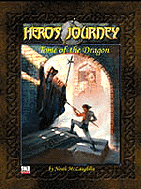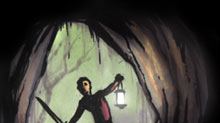by Demian Katz
 You may recall that I vowed not to waste my time on another Citizen Games module after encountering their miserable debut effort, The Secret at Greenrock. Well, it seems that my mind can't stay entirely closed for long; several people have requested that I examine another entry in the Hero's Journey series, and this has led me to take a look at Tome of the Dragon, the third adventure set in the rather vaguely-defined setting of Myrra. This product appears to have corrected a few of the mistakes of its predecessor, but it's still far from being worthwhile.
You may recall that I vowed not to waste my time on another Citizen Games module after encountering their miserable debut effort, The Secret at Greenrock. Well, it seems that my mind can't stay entirely closed for long; several people have requested that I examine another entry in the Hero's Journey series, and this has led me to take a look at Tome of the Dragon, the third adventure set in the rather vaguely-defined setting of Myrra. This product appears to have corrected a few of the mistakes of its predecessor, but it's still far from being worthwhile.
Certainly, the module sounds pretty exciting from its basic premise. Two groups of adventurers are racing to recover an ancient and magical book in the ruins of Kehilar, a former stronghold of the evil Draconis. One group consists of fiendish priests of the Order of the Black Rose, while the other group is the player characters, who (whether they realize it or not) have been hired by a force just as dark and dangerous as the dreaded Order. As the two parties wander through the crumbling corridors of the fortress, occasionally clashing with each other, a third foe reveals itself: the book itself is a sentient and evil being, and it taunts its seekers with cryptic messages in an ancient language that it transmits by reshaping the very stone of the dungeon.
If this premise were matched with an equally good execution, this would be a classic module. Sadly, though, it fails in many of the same ways that The Secret of Greenrock did. The adventure's background is extremely uneven, providing some details that are entirely pointless (in the form of a fairly lengthy but mostly incomprehensible historical extract about the defeat of the Draconis) while omitting more vital and relevant information (like details regarding the Order of the Black Rose or Kae, the lich that hires the player characters). The overland trek which starts off the adventure is punctuated by random encounters, but these encounters are simply battles with monsters. No setup, no context, just "roll 1d8, look at the table, and attack the players with the chosen monster." Even worse, once these bland fights are resolved and the real mission begins, it turns out that the trio of evil priests that oppose the heroes throughout the adventure are also nothing more than names and statistics - no personalities or histories, though there are at least some battle tactics provided for a final confrontation. Even though the introduction to the module vaguely suggests the way that the described dungeon locations, NPCs and puzzles are supposed to be brought together into an interesting whole, there's very little help given to the DM. If a good gaming session were to come of this module, it would be almost entirely due to the hard work of a creative DM. Of course, I suspect that such an individual could come up with a great adventure based solely on my summary of the quest, thus saving $9.95 worth of wasted paper.
The dungeon design that fills up most of this wasted paper is predictably bare-bones; in fact, it's so lacking in personality that it almost could have been computer-generated. Each room provides a description of one or two furnishings in the boxed text along with a monster and/or trap and, in many cases, a big pile of well-hidden treasure. In the few cases where something vaguely unusual is discussed in a room description, it's generally some weird detail about the monsters, like the fact that the Fiendish Large Monstrous Scorpions in room 9 have taken "a strange liking" to an entirely mundane tripod that once suspended a pot in their home and thus present it with "various vermin and things they scrounge and kill about the dungeon." Details like this may amuse the DM, but since they could never really be conveyed to the players in any meaningful way, they serve as little more than pointless space-filler. And speaking of monsters and pointless space-filler, I was rather shocked to discover that Appendix A of the module contains details of the adventure's "non-standard creatures," half of which are monsters copied straight from the Monster Manual but with their stats increased slightly and their names augmented with the word "Advanced." Is that covered by the Open Gaming License?
The cryptic language spoken by the book of the title is perhaps the biggest disappointment of all in the module. All too predictably, this indecipherable language, which the players can't even use magic to comprehend, is (take a moment and guess -- I bet you can figure it out!) a cryptogram puzzle involving a bunch of weird symbols listed in one of the adventure's appendices. This sort of thing seems better suited to the back of a cereal box than to a D&D adventure, and it leads to all sorts of tedium. The DM is expected to translate various trite and meaningless messages into this arcane script and hand them to the players to decipher. As if this weren't bad enough, before even getting into the dungeon, the party must first translate a long passage of the stuff and then figure out that they need to speak it aloud in order to open a vital door. The whole thing is so simultaneously obvious and obscure that I imagine most groups will either get it right away and be disappointed or never figure it out at all and be terribly frustrated. What a waste!
As with the previous Hero's Journey module I reviewed, this relatively dreary content is undeservedly given a fairly attractive presentation. The artwork isn't as impressive this time around, but it's more than adequate, and the layout is pleasant despite some minor glitches (one paragraph of "boxed text" is missing the box) and typos (the word "rubble" is mistyped as "rumble" at least twice). The maps remain the weakest aesthetic point of the booklet, being obviously computer-generated, but at least they say which way is north this time around. There's also a bit more value for money here, since for just a dollar more than the price of The Secret at Greenrock, you get half again as many pages. I'm not saying that 45 pages for $9.95 is a great deal, but itís certainly better than 30 pages for $8.95.
The contents of these extra fifteen pages are a bit of a mystery, though. First you get a four-page mini-adventure written by W. Jason Peck called "Knuckle Dragon." It's aimed at a lower-level crowd of characters than the main adventure is meant for, which seems a little odd, and it's full of typos. But "Knuckle Dragon" is probably the strong point of the book: a brains-over-brawn adventure with a lot of humorous potential. I plan to adapt it as part of my Arrowflight campaign in the near future. This mini-adventure is followed by the two "secret societies" promised on the back cover: Queen Titania's Faerie Court and the Shield Historians. I always find this sort of information rather boring, and since neither of these societies feature in either of the booklet's adventures in any way whatsoever, I can't help wondering why they were included here. I mean, this space could have been used to provide useful (and, in some cases, desperately needed) information relevant to the two adventures. Gratuitous extras like these seem better suited to the publisher's web site.
As you can see, my opinion of Citizen Games' efforts remains pretty low. There were some good ideas here, which is more than could be said for The Secret at Greenrock, but the execution is so minimalistic, disorganized and uninventive that I am left feeling more irritated than anything else. Last review, I suggested buying an issue of Dungeon instead of one of these modules. That suggestion stands.




